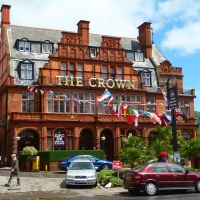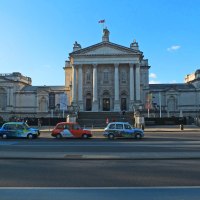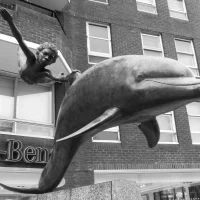With it being January and that time of year when people strive to lay off of the booze, I thought now would be an appropriate time to examine a certain derelict building which can be seen rotting away on Hampstead Road close to Euston station.

The former London Temperance Hospital as seen from the junction of Hampstead Road and Cardington Street
These mouldering remains were once the London Temperance Hospital, an institution set up by the National Temperance League in the 1870s with the aim of providing medical treatment without the aid of alcohol.
At the time, alcohol (abuse of which aside) was generally seen as a healthy, positive substance (hardly surprising considering the filthy, disease-ridden water people had to endure) and was widely used to cure patients suffering anything from malnutrition to delirium. It was also not unusual for hospital staff to enjoy the odd tipple whilst on duty…
The Temperance Society on the other hand viewed alcohol as a curse which lay at the very heart of society’s ills, and their specialist hospital therefore discouraged the use of alcohol in treatment– although it wasn’t entirely ruled out, its use being tolerated in “exceptional cases.”
When it was first founded in 1873 the London Temperance Hospital was originally based on Gower Street, Bloomsbury. It moved to the larger, purpose built premises on Hampstead Road in 1885 where it was put under the control of a board of twelve teetotallers.
The land upon which the new hospital was built was purchased from St James’s Church– the ground being previously occupied by a chapel and the St Pancras Female Charity School (i.e. workhouse).
By all accounts the hospital was a great success and its policy of refusing to store stocks of alcohol resulted in thousands of pounds being saved every year.

London Temperance Hospital children’s ward, 1897- complete with fireplace in the middle (image: English heritage)
*
Being so close to Euston, the hospital found itself on the front line in April 1924 when a specially chartered train carrying football supporters from Coventry en route to the Cup Final crashed with an electric train from Watford in a tunnel close to the station.
Four passengers were killed and many more injured, including the elderly driver who was trapped beneath heavy machinery for five hours.

The train driver being carted to the London Temperance Hospital after enduring a five hour rescue (image: London Illustrated News)
A less serious accident occurred later that same year when a bus crashed right outside the hospital… the driver of which, John Summers was found to be drunk! Perhaps fate was trying to tell him something…
*
In 1931, American tycoon Samuel Insull gifted the princely sum of $160,000 to the hospital allowing an extension to be created. Insull’s name can still be glimpsed on the newer building today.
Shortly after Insull’s donation the hospital was renamed the National Temperance Hospital. It merged with the NHS in 1948 and was formerly closed in 1982.
The building found further use however in 1986 when it was leased to the organisation, Freedom from Torture who adapted the facilities for the treatment of victims of torture from across the world.
Over 1,000 people were treated at the hospital, but the unit was sadly forced to close abruptly in 1990 following budget cuts.
The building limped on, finding use as a clinic and training centre, but has lain empty since 2006 and is now in a dreadful state, strangled by weeds, its windows cracked, ornate balconies rusted and basement flooded.
If the planned High Speed Two rail project goes ahead it is likely the old Temperance hospital will be swept away forever.
Sneaky images of the hospital’s ruined interior, taken by an intrepid urban explorer, can be viewed here.



















I lived across the road from this building from 2000-2012, in Cumberland Market. I used to catch the bus outside it every day, from 2004-2012, on my way to work near Trafalgar Square. I always thought it was ironic, that street-drinkers and alcoholics would congregate outside regularly, given its original intentions…
Best wishes, Pete.
Cheers, Pete enjoyed your comment 😉
This is a really interesting post. I remember going past this building on the bus a few months ago and wondering what its history was, so thank you!
Hannah
Many thanks for your kind words, Hannah. Glad I was able to help you solve the mystery 🙂
Very interesting story, it’s a pity the powers that be have so little respect for history and allow this building to become part of the “housing market”! My Grandfather was a dedicated member of the Sons of Temperance, but I’m afraid with time I converted back! John
>
Thanks guys 🙂 Hope you’re both well.
[…] Remember that derelict building I saw near Euston on the recent Northern Line Leslie Green walk? Well A View From The Mirror has found out what it was for. […]
It seems such a shame that buildings such as this can’t be renovated – even though I realise it would cost many millions. In our neck of the woods they convert Victorian schools and fire stations into flats – which are certainly not cheap to buy.
No members of the Temperance movement in my family history – quite the reverse really!
I know what you mean, Andrina…
Very interesting post! I work in one of the hotels in Cardington St and I see it almost everyday. I´ve been wondering what was it for a few months! Interesting! 🙂
I hope they find out what to do with it, but we have to wait to see what will happen with Euston station and d HS2…
Adriana
Thanks Adriana 🙂
I grew up in Gordon Square and can remember walking past a hospital with outside balconies on each floor….would this have been the rear of the Temperance?
Hi Sandra, perhaps you’re thinking of St James’ Gardens? These are between Hampstead Road and Cardington Street- from Cardington St you can see the back of the hospital.
We used to go to the national temperence hospital for drug treatment in 1994 to 96.we gave clean urine samples as we had a baby. Now my son is 24 and my mother has lied to him and said we were on drugs. I don’t know how to get the records that proved we weren’t using that he wants to see. Can someone help me get the records so I have the proof I need to show him?
I used to live in Hampstead Road when I was young and the Temperance Hospital was opposite us a little further down. When I was 5 I was injured at Netley Street Primary School and I was taken to that hospital. Such a shame it couldn’t be renovated and used for something.
I was a staff member in 1960, absolutely loved the place and it’s history. Moved out of London in 1968 but at heart still a North Londoner.